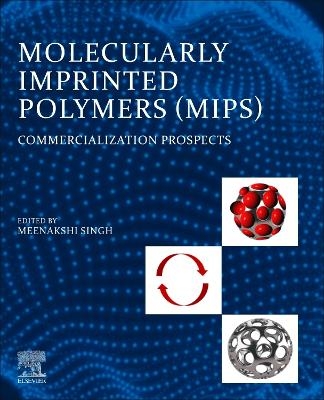
Molecularly Imprinted Polymers (MIPs)
Elsevier - Health Sciences Division (Verlag)
978-0-323-91925-8 (ISBN)
This is a valuable resource for all those with an interest in the development, application, and commercialization of molecularly imprinted polymers, including researchers and advanced students in polymer science, polymer chemistry, nanotechnology, materials science, chemical engineering, and biomedicine, as well as engineers, scientists and R&D professionals with an interest in MIPs for advanced applications.
Prof. Meenakshi Singh is a Professor in the Dept. of Chemistry, at Banaras Hindu University, in India. Prof. Singh’s research is currently focused on designing novel polymeric formats for crafting molecular recognition elements to device sensors for biomolecules/drugs/proteins/virus using molecular imprinting technology. These functionalized polymeric frameworks are incorporated in analytical technology based on molecularly imprinted polymers for detection of target molecules. The molecular imprinting technique using zwitterionic polymeric format functionalized over surface for scrutinizing their bicompatibilty. Additionally, theoretical predictions of geometry and other vital parameters of newly synthesized monomers using ab-initio methods are also carried out. Polymeric hydrogels/organogels are also designed and examined for their characteristics to explore their application as functional materials for application in drug-delivery, waste-water treatment and/or other industrial applications. The group has shown water-compatible imprinting with novel polymer format in which the entire imprinting protocol is followed in water only for selective and sensitive detection of many drug molecules amino acids, peptides, proteins by molecular imprinting. Recently this laboratory is working on development of diagnostic tool for common diseases through ‘epitope imprinting’ approach for detection of proteins from virus/bacteria causing infection. This approach was successfully tested on patients and has already been reported in journals through publication of papers. Prof. Singh’s interests also include environmental chemistry, solid phase extraction, solid phase microextraction, electroanalysis and detection principles for chemical analysis. Currently, her group are engaged in developing MIP-QCM-sensor for biomolecules. A pioneer in the field of molecular imprinting in India. Prof. Singh has published 61 articles in international peer reviewed journals. 3 book chapters, and 1 book, with more than 400 citations.
1. An introduction to molecularly imprinted polymers
2. Inefficient removal of template as a limitation of molecular imprinting of polymers
3. Computer aided modelling and theoretical calculations for rational design of MIPs
4. Role of monomer compositions in molecular imprinting
5. Material selection for fabrication of MIP based devices: An overview
6. Signal generation in MIP sensors: a critical analysis
7. Adaptability of MIPs for cutting-edge technology to devise cheap sensing tools
8. Molecularly imprinted polymer in electrochemical sensing – a step closer to achieving technology readiness
9. Molecularly imprinted polymers in optical sensing – an outlook for future
10. Stimuli-responsive imprinted polymers: Synthesis, application, and commercialization prospects
11. Biopolymers and their nanoparticles as imprinting matrix - introspection and commercialization prospects
12. Challenges in protein imprinting via epitope approach
13. Molecularly imprinted polymers: applications and challenges in biological and environmental sample analysis
14. Challenges in molecularly imprinted polymers in competition with biosensors at commercial scale
15. Patents based on molecularly imprinted polymers: exploring their commercial potential
16. Commercialized materials based on MIP
17. Commercialization prospects for MIP: A summary
| Erscheinungsdatum | 10.07.2023 |
|---|---|
| Zusatzinfo | 150 illustrations (40 in full color); Illustrations |
| Verlagsort | Philadelphia |
| Sprache | englisch |
| Maße | 191 x 235 mm |
| Gewicht | 450 g |
| Themenwelt | Naturwissenschaften ► Chemie ► Physikalische Chemie |
| Naturwissenschaften ► Physik / Astronomie ► Festkörperphysik | |
| Technik | |
| ISBN-10 | 0-323-91925-1 / 0323919251 |
| ISBN-13 | 978-0-323-91925-8 / 9780323919258 |
| Zustand | Neuware |
| Haben Sie eine Frage zum Produkt? |
aus dem Bereich


